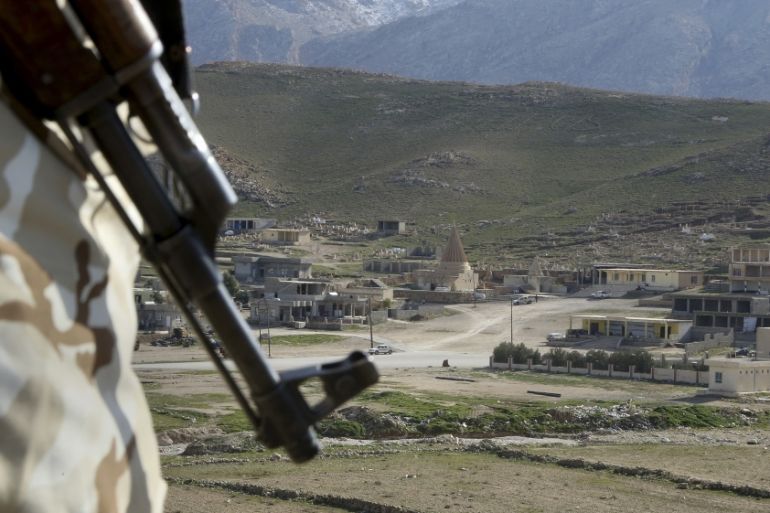Analysis: Is Sinjar the new Kobane?
Much like Kobane before it, the town in northern Iraq was pitted as the decisive battle in the war against ISIL.

In the ninth century, the Sinjar Plain was the site of important mathematical discoveries by Persian scholars, such as Muhammad al-Khwarizmi (or, Algoritmi). In Medieval times it was populated by Assyrians, Arabs, Kurds, and Persians. Until recently, it was home to most of Iraq’s Yazidi Kurds.
Today, Sinjar is a crucial battleground where the town’s mathematical history may be at play. The sum of all Kurdish forces, after all, may result in a victory in what has become the latest flashpoint in the war against the Islamic State of Iraq and the Levant (ISIL).
Keep reading
list of 4 itemsPalestinian Prisoner’s Day: How many are still in Israeli detention?
‘Mama we’re dying’: Only able to hear her kids in Gaza in their final days
Europe pledges to boost aid to Sudan on unwelcome war anniversary
Sinjar, a town in the historic Nineveh province in northern Iraq, first garnered international headlines in August 2014 when ISIL fighters pushed out Kurdish Peshmerga forces, and slaughtered somewhere between 500 and 2,000 Yazidi civilians.
The “Sinjar Massacre” fuelled a mass exodus of Yazidi Kurds from the area, and spurred accounts of Yazidi women being abducted as sex slaves for ISIL fighters. Five months later, Kurdish forces attempted to enter Sinjar but their advance was thwarted by ISIL.
The Kurdish defeat dealt a bitter blow to the Kurdistan Regional Government (KRG), and has been a festering issue in inter-Kurdish affairs. Rival Kurdish parties have been exchanging blame for months, with the Kurdistan Democratic Party (KDP) accused of succumbing to pressure from Turkey over the role of the Kurdistan Workers’ Party (PKK) and its Syrian affiliate, the People’s Defense Units (YPG), in the fight against ISIL.
Decisive battle?
During the anti-government protests in Sulaymaniyah last month, when KRG Parliament Speaker Yousef Mohammed was barred from entering the regional capital, Erbil, the opposition politician quipped: “The forces that stopped us from entering Erbil would have been enough to liberate [Sinjar].”
Not unlike the Syrian border town of Kobane, Sinjar is now pitted as the decisive battle in the US-led campaign against ISIL, fought on the ground by tens of thousands of Kurdish forces. International media has focused on the beleaguered town and its residents, with little explanation as to what strategic value its win or loss actually carries.
This time last year, the significance of Kobane was widely debated, with many saying the town was worth liberating for its symbolism alone, while others suggested that allowing it to remain besieged by ISIL would hasten the fall of the de facto autonomy Syrian Kurds had achieved a few months earlier.
A year on, it seems that Kobane was nothing more than a red herring.
READ MORE: Kurdish fighters enter centre of Sinjar
According to Michael Knights, a Lafer Fellow at the Washington Institute for Near East Policy, Sinjar is of significant strategic value because it is a vital artery of communication between the two ISIL capitals in Iraq and Syria.
“The Sinjar to Baaj areas of the Jazira desert is the main military, political and economic line of communication between the two ISIL capitals – Raqqa and Mosul. If this corridor is occupied by Kurdish forces, the caliphate is split in two,” he explained.
Contest for public opinion
But if Sinjar is a decisive battle in the war against ISIL, it is equally critical in the contest for Kurdish public opinion. Critics of the KDP-controlled KRG suggest the Sinjar operation is nothing more than a staged spectacle to boost their flailing popularity. Since it began on Wednesday, the Iraqi Kurdish authorities have used social media to disseminate a blow-by-blow account of the military operation.
Still, most Kurds are aware the initial operation to free Sinjar was actually fought by the Syrian Kurdish YPG. There is growing annoyance on the street at the political jockeying for credit, with the masses tiring of the propaganda being peddled on the local news channels of all the parties.

The frustration over the lack of effective coordination between the various Kurdish forces bubbled over last week when, at a talk in Washington DC, Lahur Talabani, head of the Zanyari Intelligence Service, lambasted the Kurdish Security Council (KSC) for being too partisan and favouring KDP initiatives – a charge the KSC denied, countering that Talabani himself was acting in a partisan manner.
While the political impasse remains between the various Kurdish parties, it seems with “Operation Free Sinjar” – at least on a security level – the parties are working together. It is the first time in Iraq that the PUK, KDP, YPG and the PKK have all coordinated an attack against ISIL. Any successes achieved in this operation will be Kurdish successes, not partisan ones.
A source close to the Patriotic Union of Kurdistan (PUK) command of the units in Sinjar told Al Jazeera: “This is the first time all the forces have genuinely coordinated together in battle. We welcome the change, it means we are a much stronger and more efficient force as we drive ISIL out and break the caliphate in two.”
Some corners of the local Kurdish press persist on peddling the partisan card, but as with other strategic flash points such as Makhmour and Jalawla, the Kurds have achieved better results when multiple factions have fought together to push ISIL out.
While they appear to have been successful in Sinjar, it remains to be seen whether this will mark a sea change in local politics.